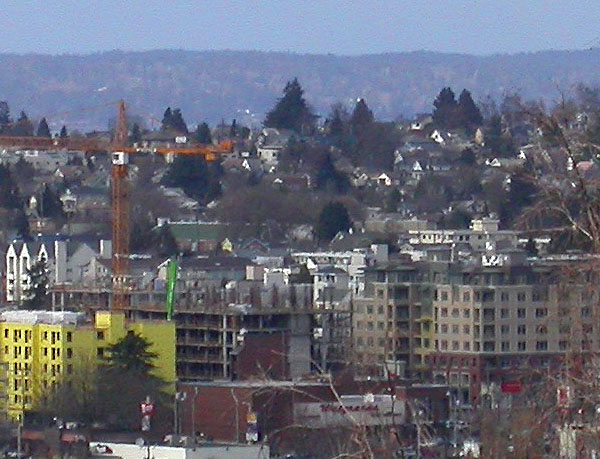To Incent Or Not To Incent?
This is pretty much a done deal: On Monday Seattle City Council is expected to approve a new plan for workforce housing incentive-zoning. But as much as I support the idea of incentivizing affordable housing in Seattle, my weak little brain is wracked with ambivalence over this approach. In short, my niggling angst is over whether the overall effect may be to impede development at the higher densities that are needed to move the City towards a more sustainable future .
For example, would the proposed six-story project at 23rd and Union be feasible for the developer if there was an additional condition attached to the upzone from 40 to 65 feet? This is a project that, given its location, would make a major contribution to the public good by its mere existence.
In the case of upzones from 65 to 85 feet, construction type plays a role that does not appear to be widely appreciated. Seattle building code allows a maximum of five stories of wood construction on top of a concrete base, a.k.a. the “five-over-one.” This construction type is relatively economical, and that’s why they’ve been sprouting up all over the City over the past decade or so.
But to go higher than five stories above a concrete base, code requires either steel or concrete frame construction, which tends to be more expensive. So it typically requires many more stories of building to offset the additional cost of construction, and the two extra stories you get by raising the height limit from 65 to 85 feet usually aren’t enough.

In the entire City of Seattle, I know of only two eight-story residential buildings that came out of the ground in the last development cycle (I trust y’all will correct me if I’ve missed any). The photo above shows those two buildings, which happen to be almost directly across the street from each other on Market Street in Ballard, just west of 15th Ave. One is steel frame and the other is concrete frame (the one clad in yellow is a five-over-one).
Would the developers of these two projects have gone for the two extra stories — which already required more expensive construction — if they had to cover the additional financial burden of affordable housing? It’s impossible to know for sure, but in neighborhoods where rents are lower than those in Ballard, the likelihood of developers opting for the 65 to 85-foot bonus is likely to be fairly low.
So then, how much financial burden would the incentive-zoning actually impose? Take for example a building with five floors of residential and 20 units per floor. Two more floors would add 40 units, and the 17% set aside would stipulate seven workforce units out of a total of 140 in the building. Those seven units would sell or rent for a lower price than the rest, but not by a drastic amount in most cases, since eligibility is based on 80 to 100% of area median income. For a 40 to 65 foot upzone, the impact is a little bigger proportionally: the building would end up with seven workforce units out of 100 total.
The armchair analysis above suggests that the financial hit would be relatively small, though for certain locations and market conditions it still might be a show stopper.
Yet another consideration in all this is that many other cities — including Boston, New York, San Francisco, and San Diego — have implemented inclusionary zoning that is much more demanding than the incentive zoning proposed for Seattle (inclusionary zoning as typically defined is not legal in Washington State). Currently in San Francisco, for multifamily projects with ten or more units, 15 percent of the total units must be affordable. Results have been mixed but generally positive (pdf), and dense housing development didn’t grind to a halt as some had probably feared.
Ambivalent yet?
While there are those who never seem to get beyond scapegoating the developers, the reality is that the community as a whole should be footing the bill for affordable housing. And Seattle already has an affordable housing incentive known as “Homes Within Reach” that reflects that perspective. The program offers up to a 12 year property tax exemption for multifamily projects that provide housing affordable to “moderate-wage” workers.
The smart thing about the tax exemption incentive is that it’s decoupled from density. Affordable housing and density are both key components of balanced sustainability, and nobody wants an incentive that may have the unintended consequence of pitting one against the other. Will this happen with Seattle’s new incentive zoning? Maybe. Then again, maybe not…
